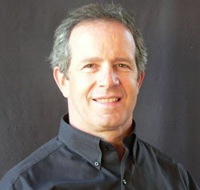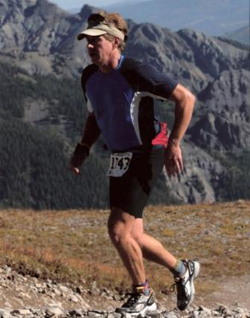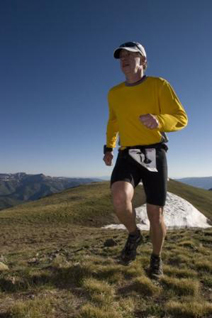Dr. Robert Gilbert
Bob Potter 11/17/08 Dr. Gilbert
Bob Potter's story
Bob: "Here was one of my first postings asking if it was too soon. As it turns out, Dr. Gilbert said my OA was one of the worst that he had seen, so clearly it was not too soon." Thursday, August 28, 2008
All,

I am do for resurfacing with Thomas Vail at UCSF in November. My question is am i doing it too soon?
I have read and listened to the case studies. In most cases people
seemed to be in far worse shape that I am now. I can't run or play
tennis any more, and if I "tweak" my hip I can be in a lot of pain for
a few days.
On the other had I can walk 9 wholes (2 Advil) with some pain and
fatigue. I can ride a mountain bike for a couple of hours, etc.
Generally anything where I move my leg forward is OK. Sideways is
impossible and back is a challange.
Should I wait or get it over with before it gets really bad?
Thanks, Potter
Monday, December 08, 2008
I know it has been helpful for me to see what others are going through at any given time during their recovery. In that spirit let me share my experience so far.
Generally I am feeling great in the morning, so so in the late afternoon and uncomfortable at night. I take Advil during the day and Vicodin at night. Three times I have been too aggressive with PT and my achy body at night told me to dial it back. Although I shouldn't be, I am surprised how slow the progress is every day. I fully
expected to be walking unassisted by now despite what I read here. The reality is that I am using a cane around the house and a crutch around the block. I drove for the first time today. No problem. Got my Handicapped parking sign, went to the bank and picked up a few things at the store.
Here is what my day looks like 3 weeks after surgery:
- 7 am - bed PT - toe points, knee flex, butt flex, knee lift, leg sweeps, crunches
- 9 am - 2 Advil, standing PT - tows/heels, squats, side slide, knee lift, foot to butt
- 10:30 - Morning walk around the block with 1 crutch. (Have been using cane around the house since end of week 2)
- 12 to 2pm - lunch, nap (can do that because I work from home) Advil
- 2 pm - bed PT (see above)
- 3 pm - afternoon walk around the block
In between all of this I am trying to get work done on my Lazy boy, feet up, occasionally icing or heating.
Usually around 4:30 to 5 pm discomfort and fatigue set in. Leg feels a bit like it is going to sleep. I feel a bit tired and flu ish, contrary to mornings when I feel strong and pain free.
- 5 pm Advil
- 10 pm Vicodin, read and go to bed. Can sleep on both sides and back. Hip is much more achy at night particularly if I have over done it
- 2 am Vicodin - Maybe one more Vic before night is over
From what I have read here this is probably all pretty typical. If not, let me know.
Cheers,
Bob
Things started improving rapidly after week three…..”
Monday, December 15, 2008
Well that was the best week yet as far as improvements go. Got rid of the crutch early. Now am walking without the cane around the house and for some of the daily walks. Not nearly as tired and achy in the
afternoons and evenings. Still the occasional Vicodin or Advil for ache during the night. Mood is definitely improving as hip is improving.
I have been watching a few of you who are a week or two ahead of me. Looking forward to doing what you can do. Keep posting.
Cheers,
Bob - 53, RBHR, Gilbert, 11 17 08
Monday, December 29, 2008
With all of the Holiday activity I missed my 5 week post op posting. On my 5 week aniversary date I had an appointment with Dr. Gilbert in San Francisco. He asked me to walk up and down the hallway and then told me
that I was one of his faster healers and that I could do anything but jog. He did recommend that I not play tennis for another 4 weeks.
During the first three weeks, improvement seemed very slow. Then during the 4th week, I no longer needed the cane and things began to improve rapidly. I even caught myself jogging to get through an intersection. Yesterday I spent 5 hours touring San Francisco withfamily from out of town. Miles of walking. My hip was definetely achy by then end of the day.
Today is my 6 week anniversary. My hip feels almost normal during the day but I still take advil at night particularly if I work it too much. I have to focus not to limp as the muscles in front are still not used to letting me bring my leg all the way back when I walk.
I have a long way to go to get back in shape, but am feeling quite blessed that day to day acitivites feel just about back to noirmal.
Until next week, Happy New Year to all of you and thanks for all of your contributions and support.
Cheers,
Bob (53)
RBHR, Gilbert, 11-17-08
Wednesday, December 31, 2008
Lee,
I played 18 holes of golf yesterday. Shot a 92 – pretty much right where I was before surgery. I took Advil before and during play. I am out of shape – breathing hard climbing to higher holes, but feel as though I could get back in shape pretty quickly. I swam 2/3 mile two days ago. I think I could lift 50 lbs with no risk. Having said all of that, I don’t think I would be ready to be a fireman for a while. Dr. Gilbert told me I was one of his fastest healers. I think that was because I was in great shape before I went in. I would tell them that you may be back in 3 months, and then surprise them when you come back in 2.
Bob
Brian Gilbert - RBHR March 28, 2007, Dr. Dungy
Approaching 50 was really no big deal for me, at least not until a routine physical exam and x-ray screening in the summer of 2007 revealed I had degenerative arthritis in my right hip. After staring at my chart for some time my physician asked how much I was running. I explained I'd competed in two ultras and a marathon in the past three months. "Maybe at your age its time you learn how to ride a bike," he dead-paned. I failed to see the humor. I had two bikes but riding was something I did when I needed a break from running.
 
A deteriorating hip for a middle-age runner is perhaps the worst news possible. True I'd been nursing a tender right hip for more than a year since injuring myself running a fast downhill section of a marathon but I was not prepared to accept the end of my racing career and probably as my main form of exercise. My long term condition was unclear although one thing was for certain, running high mileage was not in the doctor's orders. My condition was complicated to say the least. I naturally had a shorter right leg and slightly tilted pelvis that threw my stride off and undoubtedly increased stress on my right hip. How much my condition was due to that minor birth defect versus pounding out ultra-marathons in my late forties was unknown however. A bigger problem than my health was my vanity. I had lived and trained for over twelve years in the northern mountains of Arizona at an ideal altitude of 7,000. In the previous year I'd set a personal best in a Colorado 50 mile mountain race, set an age group record at a Prescott, Arizona mountain marathon, and won the masters division in a Tucson road half-marathon. After struggling to compete in the sub-masters category for years I was looking forward to kicking butt in the 50 year-old masters category or so I thought. Unfortunately, common sense didn't prevail and against doctor's recommendations I ran the Imogene Pass mountain race in Ouray, Colorado the following September. I actually finished respectively but at considerable cost cursing the pain at every step in the final 5 miles. Running through pain is one thing but this seemed sadistic so I was ready to concede.
I returned home and promptly canceled any upcoming race plans and running magazine subscriptions. In October, I underwent an MRI with a local orthopedic surgeon who confirmed the next depressing chapter for me; I not only was suffering from arthritis but advanced vascular necrosis (AVN) on my right femur. The internal bleeding explained the rapid deterioration of my hip and shrinking range of motion as I was now starting to mash bone on bone. The most depressing aspect for me was that suspending running offered little escape. I had pain walking, lowering myself into a chair, and even sleeping. A steady diet of anti-inflammatory medication and aspirin provided only minor relief.
Over the next few months my exercise regiment without running became steadily more dull. I was able to do some recreational skiing with my son if I limited my range of motion although it became increasingly more difficult to bend at the waist to buckle my boots. As a matter of fact, just putting on shoes in the morning was something I dreaded. A particularly low point came one day while attending a seminar in downtown Phoenix when I found I could barely walk three blocks, stopping to rest on a bus bench. I didn't feel 49, I felt 89. As the fall worn on I found it difficult to crawl into my SUV or truck and I found myself eyeing handicap spaces at the mall. By Christmas time I was reduced to swimming and stationary cycling although climbing out of the pool was difficult and lifting my leg over the bike stand was a slow agonizing act.
Being a non-runner was not something I ultimately ha d the patience for so my New Year's resolution became researching what other aging jocks with blown hips were resorting to. In late January after reading a number of blogs on sports injuries I stumbled upon the Birmingham Replacement website and read about a successful BHR performed on Floyd Landis and his hopes for returning to competitive cycling. I also read about some individuals that were able to run after a successful procedure. This seemed to offer promise I thought although I didn't want to get my hopes up yet, still it was hope. There were only two surgeons in Arizona certified in the BHR technique at the time, so I booked the first one available, Dr. Danton Dungy. I was ready to be fixed.
At my initial screening Dr. Dungy was encouraging but not overly enthusiastic. Much like the advice of my primary physician and orthopedic, he stressed that the procedure was not without risks. My conditioning made me a good candidate but he had concerns about my AVN so it was quite a surprise when he called me in a couple of days and said he thought it was a good option. A risk of doing nothing was that the AVN would advance and eventually soften the head of the femur until a BHR was no longer possible. He also explained that a BHR was a complicated surgery and success can depend upon a surgeon's judgement and skill during the operation. In other words, once the hip joint is separated and connective cartilage removed from the socket the only outcome is to finish a BHR or break out the saw and do a traditional THP! He didn't actually say saw but I had watched enough YouTube videos on the subject to have a pretty good mental picture. Dr. Dungy didn't strike me as a great risk taker though and projected confidence so I felt I was literally in good hands.
Not wanting to give myself too much time to think I rushed to have my surgery date set for March 30, 2007. The day I left for the hospital I found myself lingering in the garage looking over my ski and mountain gear, wondering if I would use it again. It was too late to turn back now so I tried to not dwell on the worst and focus on success. I didn't really fear my first major surgery so much as I feared the potential of waking up with a THR, so as soon as I regained consciousness in recovery my first words to the attending nurses were "did it work?!" It was only after my wife walked into the recovery room that I relaxed and believed it. Throughout my hospital stay I was surprised to learn that most PT and nursing staff were unfamiliar with the BHR and I was only too anxious to explain the benefits ad nauseam to anyone that would listen.
I attacked physical therapy with a vengeance and recovery became my new sports conquest. In two weeks I was off crutches and walking with a cane; in six weeks I was walking normally, and at 12 weeks, doing light jogging. Over the next six months the progress came in spurts and with several setbacks that would cause me to slow down or even take time off. My right leg was lengthened slightly from the surgery and I found myself running at an angle on the treadmill now that I was more properly aligned. In many respects, I needed to learn to run again and I suffered from phantom pain and a reluctance to stride evenly and trust my new hip. At other times I found everything was sore except my new hip. My front flexor muscles would ache after only about 15 minutes and I found myself suffering from a sore back and tight hamstring muscles. I constantly had to work against the tight internal scar tissue and inflammation that would flair up then subside. Nonetheless, I was progressing to become a relatively pain-free runner again albeit a very slow one. I even ran a 2-mile fun run at six months post-op and at thirteen months post-op competed in a 10-K, one of my slowest times but it was one of the most satisfying finishes in years.
Today, at over 18 months post-op I can't say I'm the runner I was ten or even five years ago and probably never will be. I spend ample time stretching each day and average 30 to 40 miles per week in addition to some weight lifting, cycling, and lap swimming. I even take the time to go walking or hiking on occasion with family and friends. I don't indulge in anti-inflammatory medication of any type, even aspirin but I take extra calcium and omega-3. My recovery is such now that I tend to dwell more on my aerobic conditioning rather than my new hip and I even forget about it altogether at times unless my co-workers or kids chide me as the bionic man. I'm even working up to a half-marathon later this year and even though I'm not sure if an ultra-marathon is anywhere in my future I wouldn't rule it out.
My philosophical outlook on my BHR is quite simple: I was blessed to have great family support, good health coverage, an understanding employer, and a great surgeon. I now have the benefit of the most technologically advanced prosthetic that has extended my active life and returned me to a normal routine although there are no guarantees that I won't have other problems down the road, which might alter my plans to continue running and competing. As a friend of mine says, "life itself is a risk activity." I say the greatest gift you can receive is hope. |
